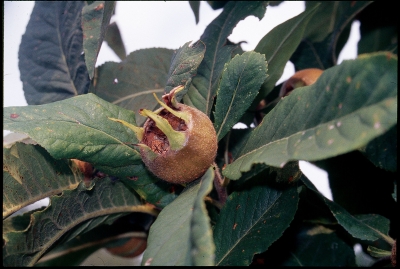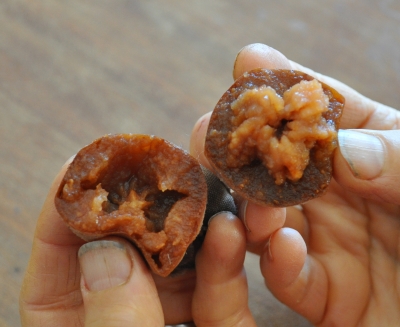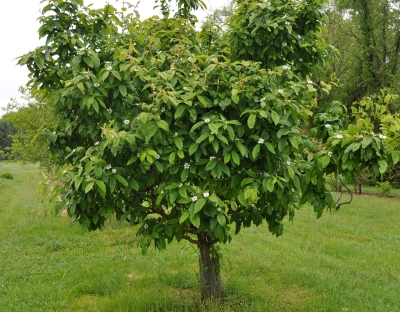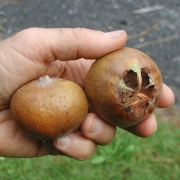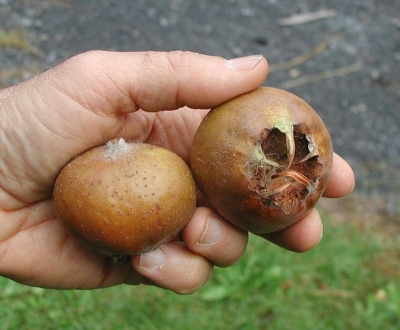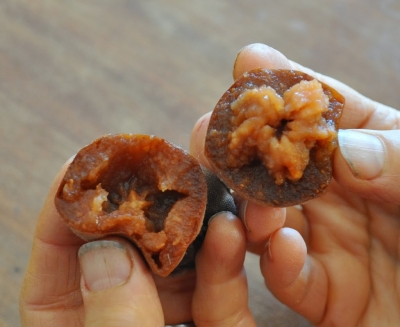POPPING, PRUNING, AND EATING
Popcorn Gets Bigger, But Medlar Is Still Ugly (Not To Me)
A couple of weeks ago I wrote about increasing the poppability of my home-grown popcorn by exposing the kernels to the vapor of a saturated salt solution. Pennsylvania Dutch Butter Flavored popcorn, a variety that usually pops fairly well, popped to 1/3 greater volume.
This week Pink Pearl, a variety that’s not usually a very good popper, underwent testing. The result: No effect of the treatment; both the treated and untreated batches popped pretty well. Was it the change in the weather, stronger hints of spring? Perhaps. (Previously, I pointed out how cold weather outside turns indoor air drier, perhaps too dry for good popcorn popping.) At any rate, Pink Pearl was tasty.
Medlar Teaches How To Prune A Fruit Plant
The weather change also had the effect of drawing me outdoors more — for pruning. Looking at my medlar tree’s branches going every which way, I scratched my head (figuratively) wondering where to start, what to cut.
Medlar is a fruit tree (more on medlar later), and the first step in pruning any fruit tree is attending to light. Light provides the energy for photosynthesis which translates into flavorful fruits. The goal is to let every branch bathe in sunlight, which also helps thwart potential disease problems.
So I stopped scratching my head and started with a few dramatic pruning cuts, lopping some of the larger limbs back to their origins. Medlar has a naturally spreading growth habit, so cuts were aimed at removing limbs trying to fill in and shade the the center of the tree. I wanted a whorl of branches reaching up and out.
Next to go were dead, diseased, and broken branches. I saw remnants of cicada damage from two years ago. Away with most of those stems also.
For the next cuts, you have to know how a particular kind of fruit tree bears fruit. At one extreme are peaches. They bear only on one-year-old stems so need aggressive pruning each year to stimulate new shoots that become next year’s bearing, one-year-old stems. At the other extreme are apple and pear trees. They bear fruit on long-lived spurs, which are stumpy, branching stubs that develop on older limbs, so relatively little pruning is needed.
Medlar’s bearing habit lies somewhere between those two extremes. I shortened a few very old branches to invigorate them with new growth.
On most fruit trees, drooping branches make poorer fruit. Probably for medlar also. So off came the drooping branches, either back to non-droopy portions or to their origin.
Finally, some detail work: shortening or removing those vigorous, vertical shoots called watersprouts; thinning out smaller areas of congested branches; removing stems growing too close to where major limbs exit the trunk; and lopping down root sprouts growing at or near ground level from the rootstock.
Besides fruit, medlar offers beauty. Part of the beauty is the craggy shape of the tree, its muscular limbs clothed in golden brown bark. I stepped back to admire the tree and my work after pruning. If I’ve done a good job, the tree looks happily ready to bask in light and air and, because the major cuts removed limbs at the origin, hardly looks like it’s been pruned.
Medlar Teaches To Eat With Your Tongue, Not Your Eyes
Medlar is a fruit whose popularity peaked in the Middle Ages. Charlemagne was a fan, a big fan who demanded the tree be planted in every town he conquered.
Despite its popularity, even in the Middle Ages, the fruit has often been described disparagingly — for its appearance, though, not its flavor. The fruits resemble small, russeted apples, tinged dull yellow or red, with their calyx ends (across from the stems) flared open. “Open-arse” was the name Chaucer chose. A more recent writer described medlar as “a crabby-looking, brownish-green, truncated, little spheroid of unsympathetic appearance. “ (All recounted, along with information about growing, procuring, and eating medlars in the chapter on medlar in my book Uncommon Fruits for Every Garden.)
Oh, one more quirk about medlar: The fruit, rock hard at harvest, needs to be bletted before eating. This means gently setting it on a counter in a cool room for a couple of weeks, or more, depending to the temperature, during which time the fruit’s interior turns to brown mush. Ugly to look at, but the flavor has a refreshing briskness with winy overtones, like old-fashioned applesauce laced with cinnamon. Between the fruits’ appearance and their need for bletting, you’ll never find medlars for sale on a supermarket shelf.
Perhaps the fruit is ugly. The tree is not. I already mentioned the attractive form and color of the limbs. The white flowers, opening here in May, are like those of a wild rose, each one enhanced because its late opening gets a backdrop of a whorl of already unfurled, dark, green leaves. The tree grows only 8 or 10 feet high and wide and will fruit without another pollinator, so is perfect for a small yard. No need to decide whether to plant a fruit tree or an ornamental tree; medlar is both trees in one.


